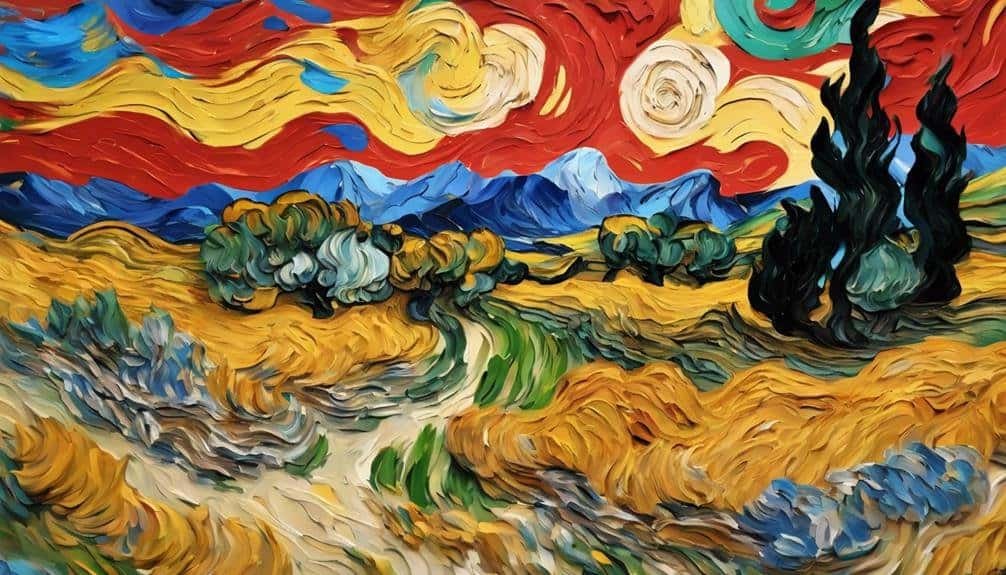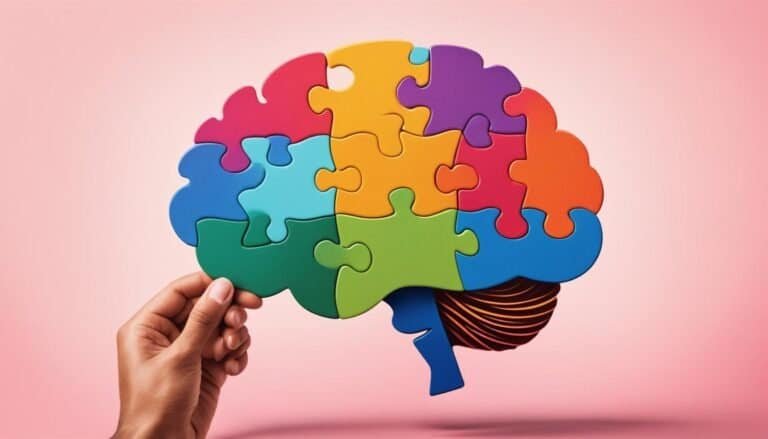Vincent Van Gogh Personality Type
Vincent van Gogh's personality type, often identified as INFP (Introverted, Intuitive, Feeling, Perceiving), reveals the intricate blend of his emotional depth and artistic brilliance. His early influences, emotional turmoil, and intense dedication all reflect this unique personality type. His art becomes a canvas for his inner world, expressing raw emotions with intensity. Van Gogh's deep connections to spiritual beliefs and philosophical musings further enrich his artistic vision. Through understanding his creative process and techniques, a deeper appreciation for his work emerges. Explore how van Gogh's personality type shapes his legacy, impact on art, and psychological complexities.
Key Takeaways
- Van Gogh exhibited an intense, passionate, and emotionally-driven personality.
- His personality was marked by deep emotional sensitivity and turbulent relationships.
- Van Gogh's communication style was direct, passionate, and reflective of his inner turmoil.
- He showed unwavering commitment and dedication to his art, beyond mere skill.
- Fiercely loyal yet prone to sudden outbursts, reflecting his complex and tumultuous interactions.
Early Life and Influences
During his early years, Vincent Van Gogh was profoundly influenced by various family members and societal norms that shaped his artistic inclinations. Van Gogh's early influences, particularly the presence of his father who was a minister, played a significant role in shaping his worldview. The strict religious upbringing and the emphasis on morality within his family instilled a sense of duty and discipline in Van Gogh, which later reflected in his dedication to his art.
Moreover, Van Gogh's exposure to art through his mother, who was an amateur artist, sparked his interest in drawing and painting from a young age. However, despite these positive influences, Van Gogh also experienced childhood trauma, such as the loss of family members and struggles with mental health issues. These early challenges contributed to his emotional sensitivity and introspective nature, which later became prominent themes in his artwork.
Emotional Turmoil and Instability
Van Gogh's emotional turmoil and instability manifested prominently in his turbulent relationships and erratic behavior throughout his artistic career. His psychological complexity was a driving force behind his artistic genius, fueling his creations with raw emotion and intensity.
Van Gogh's inner turmoil, a constant battle within his mind, found external expression through his brushstrokes, color choices, and subjects. This inner conflict often led to extreme highs and lows in his mood, reflected in the varying tones and textures of his paintings. His struggles with mental health, including anxiety and depression, permeated his work, creating a deep sense of empathy and connection with viewers.
Despite the challenges he faced, Van Gogh's emotional depth and vulnerability allowed him to tap into profound human experiences, capturing universal feelings of loneliness, despair, and longing. His art became a mirror to his soul, revealing the complexities of the human psyche in a way that resonates with audiences to this day.
Artistic Vision and Expression
Van Gogh's artistic vision was deeply intertwined with his emotional state, leading to a unique and intense creative process.
His paintings reflect a profound emotional depth that resonates with viewers, offering a glimpse into his inner world.
Through his art, Van Gogh expressed raw emotions and captured the essence of human experience with striking intensity.
Van Goghs Creative Process
Characterized by an intense and deeply introspective approach, Vincent Van Gogh's creative process in his artistic vision and expression reveals a profound connection between his emotions and his artistry.
Van Gogh drew creative inspiration from various sources, including his admiration for artists like Jean-François Millet and Jules Breton, whose works influenced his own style. His artistic influences can be seen in the way he depicted everyday scenes with a unique perspective and vivid colors that conveyed a sense of emotional depth.
Van Gogh's creative process involved channeling his inner turmoil and emotions onto the canvas, resulting in artworks that not only reflected his personal struggles but also resonated with viewers on a deeply emotional level.
Emotional Depth in Art
Emotions serve as the foundational core of artistic depth, intricately weaving through the fabric of expression to evoke profound connections within the viewer's psyche.
Emotional intensity in art is a powerful force that drives artists like Van Gogh to create works that resonate on a visceral level. Van Gogh's artistic inspiration stemmed from his deep emotional experiences, which he translated onto canvas with raw, unfiltered emotion.
The emotional depth in Van Gogh's art is palpable, drawing viewers into a world where they can almost feel the passion and turmoil that fueled his creations. Through his use of color, brushstrokes, and composition, Van Gogh captured the essence of human emotion in a way that continues to captivate audiences and inspire artists to explore further into their own emotional wellspring for artistic expression.
Intense Passion and Dedication
Through his art, Vincent Van Gogh exemplified an unwavering commitment and fervor that permeated every brushstroke and color choice. His intensity and determination were palpable in the emotional depth of his work, reflecting a profound artistic dedication that set him apart. Van Gogh's passion for painting went beyond mere skill; it was a relentless drive to express his innermost thoughts and emotions on canvas. This deep emotional connection to his art fueled his creative process, leading to the creation of masterpieces that continue to captivate audiences worldwide.
—
| Intense Passion | Dedication | Impact |
|---|---|---|
| Van Gogh poured his heart and soul into each artwork, infusing them with raw emotion. | He dedicated countless hours to perfecting his craft, constantly seeking to improve and evolve as an artist. | His unwavering commitment to his vision influenced generations of artists and left a lasting legacy in the art world. |
Relationships and Social Interactions
In his interactions with others, Vincent Van Gogh exhibited a complex and often tumultuous dynamic that shed light on the intricacies of his personality. Van Gogh's social interactions were marked by a deep emotional intensity and a unique communication style. He struggled with forming lasting relationships, often experiencing difficulty in maintaining emotional connections due to his volatile nature and the depth of his feelings.
Van Gogh's relationship dynamics were characterized by extremes – he could be fiercely loyal and devoted, yet also prone to sudden outbursts and periods of withdrawal. His emotional connections with others were profound, leading to intense bonds but also contributing to conflicts and misunderstandings. His communication style was direct and passionate, reflecting his inner turmoil and artistic fervor.
Despite his challenges in social interactions, Van Gogh's ability to express raw emotion and vulnerability through his art remains a tribute to the depth of his relationships and the impact they had on his life and work.
Mental Health and Struggles
Van Gogh's struggles with mental health manifested in a myriad of ways, often influencing both his personal life and artistic endeavors. The stigma surrounding mental health during his time exacerbated his challenges, leading to periods of extreme distress and instability. Van Gogh's coping mechanisms included immersing himself in his art, using painting as a form of therapy to express his inner turmoil. Despite his creative outlet, his mental health issues persisted, impacting his relationships and overall well-being.
Support systems were limited for Van Gogh, with few therapy options available to him. The lack of understanding surrounding mental health in the 19th century contributed to the isolation he often felt. Van Gogh's struggles highlight the importance of destigmatizing mental health and providing accessible support systems for those in need. While therapy options were scarce in his time, modern advancements in mental health treatment could have potentially provided him with the help he needed to manage his conditions more effectively.
Spiritual and Philosophical Beliefs
Van Gogh's exploration of spiritual and philosophical beliefs in his life and art reveals deep introspection and a profound search for meaning amidst his struggles with mental health. His spiritual exploration can be seen in his fascination with nature and the divine presence he perceived within it. Van Gogh's philosophical musings often centered around the interconnectedness of all things and the eternal questions of existence and purpose. Through his art, he sought to convey not just the physical reality of his surroundings but also the underlying spiritual essence he believed imbued them.
Van Gogh's letters to his brother Theo provide a glimpse into his inner thoughts and reflections on spirituality. He often expressed a deep connection to the natural world, viewing it as a source of solace and inspiration. His paintings, such as 'Starry Night,' reflect his belief in the transcendent power of art to evoke emotions beyond the material domain. Van Gogh's spiritual and philosophical inquiries were integral to his artistic vision, shaping the emotive intensity and symbolic depth present in his works.
Creative Process and Techniques
Van Gogh's distinctive brushstroke techniques, bold color palette choices, and expressive mark making are essential components that define his unique creative process.
By meticulously studying his use of thick impasto brushstrokes and vivid hues, you can gain insights into how he conveyed his emotions and thoughts onto the canvas.
Understanding these techniques allows you to appreciate the depth and complexity of Van Gogh's artistic vision.
Brushstroke Techniques
Within the domain of artistic expression, brushstroke techniques serve as the essential building blocks through which painters convey their creativity and vision onto canvas. Brushstroke dynamics play a vital role in determining the texture, movement, and overall aesthetic of a painting.
Technique evolution is evident throughout art history, with painters like Vincent Van Gogh revolutionizing traditional methods to express emotions and concepts more vividly. Van Gogh's bold, swirling brushstrokes in pieces like 'Starry Night' exemplify his innovative approach to conveying mood and energy.
Color Palette Choices
Color palette choices play a crucial role in the creative process and techniques employed by artists to evoke specific moods and convey thematic elements within their work. Artists often draw inspiration from color theory to make intentional choices that enhance the overall impact of their pieces. Vincent Van Gogh, known for his bold and expressive use of color, strategically selected hues to reflect his emotions and the essence of his subjects. Below is a table showcasing some key aspects of Van Gogh's color palette choices:
| Aspect | Description |
|---|---|
| Bright Colors | Van Gogh's preference for vibrant hues |
| Complementary Colors | Skillful use of colors opposite each other on the color wheel |
| Symbolic Colors | Utilization of colors to convey deeper meanings |
| Emotional Impact | How colors were used to evoke specific emotions |
Van Gogh's mastery of color further highlights the importance of color palette choices in the domain of artistic inspiration.
Expressive Mark Making
The technique of expressive mark making in art involves the deliberate and impactful use of various strokes and gestures to convey emotions and energy within a piece.
Artists like Vincent Van Gogh were masters of this technique, using bold and dynamic brushstrokes to infuse their works with expressive energy.
Van Gogh's intuitive creativity allowed him to create artworks that not only captured the physical reality but also the emotional essence of his subjects. Through his expressive mark making, Van Gogh was able to convey a sense of movement, passion, and vitality in his paintings.
This technique goes beyond mere representation, delving into the domain of raw emotion and personal interpretation, making it a powerful tool for artists to communicate their innermost feelings.
Legacy and Impact on Art
Van Gogh's profound influence on the art world can be observed through the myriad of artists who have drawn inspiration from his expressive brushwork and emotive color palette. His impact on modernism and symbolism is undeniable, as he paved the way for artists to explore new forms of self-expression and convey deeper emotions through their work. Van Gogh's bold use of color and dynamic brushstrokes revolutionized the art scene of his time and continues to resonate with contemporary artists striving to evoke raw emotion in their pieces.
—
| Legacy and Impact of Van Gogh on Art | |||
|---|---|---|---|
| Aspect | Description | Example | Influence |
| Modernism | Van Gogh's bold use of color and expressive style laid the foundation for modernist movements such as Fauvism. | Fauvism | Strong |
| Symbolism | His poignant and symbolic depiction of nature and everyday life inspired the Symbolist movement in art. | Symbolist movement | Enduring |
| Self-Expression | Van Gogh's emphasis on conveying personal emotions through art encouraged artists to prioritize self-expression in their work. | Expressionism | Significant |
| Emotion | The intense emotions captured in Van Gogh's paintings set a precedent for artists seeking to evoke powerful feelings in their audience. | Post-Impressionism | Far-reaching |
Psychological Analysis and Speculations
Upon delving into Vincent Van Gogh's psychological makeup and tendencies, one uncovers a complex interplay of emotions and experiences that seemingly fueled his artistic vision and output. Psychological analysis of Van Gogh often centers around his intense emotional expression, a hallmark of his work. Speculations suggest that his turbulent inner world, marked by episodes of mental illness and emotional instability, greatly influenced his artistic style.
Van Gogh's bold use of color and expressive brushstrokes is seen as a direct reflection of his inner turmoil and emotional depth. His art served as a means of catharsis, allowing him to externalize and process his innermost thoughts and feelings. The psychological intricacies of his paintings reveal a profound connection between his mental state and artistic output, highlighting the profound impact of his emotions on his work.
Van Gogh's ability to translate his innermost struggles into visually striking masterpieces showcases the power of art as a medium for emotional exploration and expression.
Conclusion
To sum up, Vincent van Gogh's personality type can be described as a complex blend of emotional intensity, artistic vision, and passionate dedication.
His turbulent life and unique artistic style left a lasting impact on the art world.
Imagine a stormy sea, with waves crashing against the shore, representing Van Gogh's inner turmoil and creative energy that continues to inspire and captivate audiences around the world.








